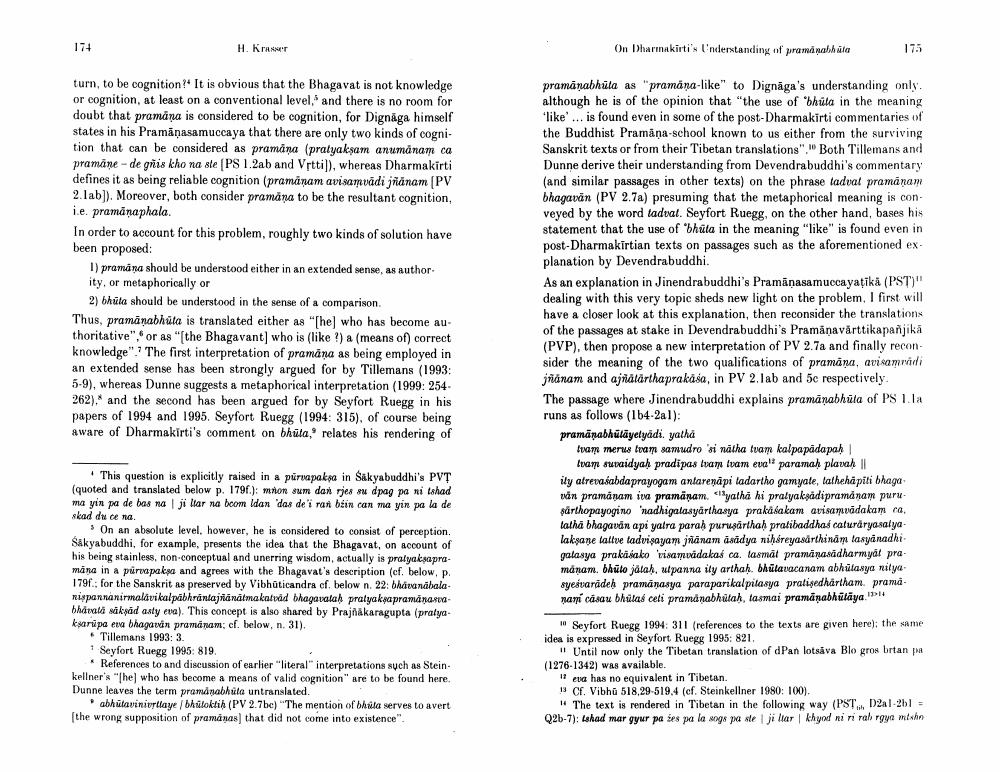Book Title: On Dharmakirtisunderstanding Of Pramanabhuta And His Definition Of Pramana Author(s): Helmut Krasser Publisher: Helmut Krasser View full book textPage 2
________________ 174 H. Krasser turn, to be cognition? It is obvious that the Bhagavat is not knowledge or cognition, at least on a conventional level, and there is no room for doubt that pramana is considered to be cognition, for Dignaga himself states in his Pramanasamuccaya that there are only two kinds of cognition that can be considered as pramana (pratyakşam anumanam ca pramane - de gnis kho na ste [PS 1.2ab and Vrtti]), whereas Dharmakirti defines it as being reliable cognition (pramāņam avisamvadi jñānam [PV 2.lab]). Moreover, both consider pramana to be the resultant cognition, i.e. pramănaphala. In order to account for this problem, roughly two kinds of solution have been proposed: 1) pramana should be understood either in an extended sense, as authority, or metaphorically or 2) bhuta should be understood in the sense of a comparison. Thus, pramanabhuta is translated either as "[he] who has become authoritative", or as "[the Bhagavant] who is (like ?) a (means of) correct knowledge". The first interpretation of pramana as being employed in an extended sense has been strongly argued for by Tillemans (1993: 5-9), whereas Dunne suggests a metaphorical interpretation (1999: 254262), and the second has been argued for by Seyfort Ruegg in his papers of 1994 and 1995. Seyfort Ruegg (1994: 315), of course being aware of Dharmakirti's comment on bhula, relates his rendering of This question is explicitly raised in a purvapakṣa in Šakyabuddhi's PVT (quoted and translated below p. 179f.): mnon sum dan rjes su dpag pa ni tshad ma yin pa de bas na ji llar na boom Idan 'das de'i ran béin can ma yin pa la de skad du ce na. On an absolute level, however, he is considered to consist of perception. Sakyabuddhi, for example, presents the idea that the Bhagavat, on account of his being stainless, non-conceptual and unerring wisdom, actually is pratyakṣapramana in a purvapaksa and agrees with the Bhagavat's description (cf. below, p. 179f; for the Sanskrit as preserved by Vibhuticandra cf. below n. 22: bhavanabalanispannanirmalavikalpäbhrāntajñānātmakatvad bhagavataḥ pratyakṣapramāṇasvabhavala säkṣad asty eva). This concept is also shared by Prajñākaragupta (pratyakṣarupa eva bhagavan pramanam; cf. below, n. 31). Tillemans 1993: 3. Seyfort Ruegg 1995: 819. References to and discussion of earlier "literal" interpretations such as Steinkellner's "[he] who has become a means of valid cognition" are to be found here. Dunne leaves the term pramanabhuta untranslated. abhutavinivṛllaye/bhüloktiḥ (PV 2.7bc) "The mention of bhala serves to avert [the wrong supposition of pramanas] that did not come into existence". On Dharmakirti's Understanding of pramaņabhūta pramāṇabhūta as "pramāṇa-like" to Dignaga's understanding only. although he is of the opinion that "the use of 'bhuta in the meaning 'like'... is found even in some of the post-Dharmakirti commentaries of the Buddhist Pramana-school known to us either from the surviving Sanskrit texts or from their Tibetan translations"." Both Tillemans and Dunne derive their understanding from Devendrabuddhi's commentary (and similar passages in other texts) on the phrase tadvat pramānam bhagavan (PV 2.7a) presuming that the metaphorical meaning is conveyed by the word tadvat. Seyfort Ruegg, on the other hand, bases his statement that the use of 'bhuta in the meaning "like" is found even in post-Dharmakirtian texts on passages such as the aforementioned explanation by Devendrabuddhi. 175 As an explanation in Jinendrabuddhi's Pramanasamuccayaṭīkā (PST)" dealing with this very topic sheds new light on the problem, I first will have a closer look at this explanation, then reconsider the translations of the passages at stake in Devendrabuddhi's Pramanavärttikapañjikā (PVP), then propose a new interpretation of PV 2.7a and finally reconsider the meaning of the two qualifications of pramana, avisamradi jñānam and ajñālärthaprakasa, in PV 2.1ab and 5c respectively. The passage where Jinendrabuddhi explains pramanabhula of PS 1.la runs as follows (1b4-2a1): pramāṇabhūlāyelyadi. yathā Ivam merus tvam samudro 'si natha tvam kalpapādapaḥ | Ivam suvaidyaḥ pradipas tvam tvam eval paramaḥ plavaḥ || ily atrevasabda prayogam antareṇāpi ladartho gamyate, tathehāpīti bhaga vän pramānam iva pramäṇam. "yatha hi pralyakṣadipramanam puruşarthopayogino nadhigatasyarthasya prakasakam avisamvadakam ca. tatha bhagavan api yatra paraḥ purusarthaḥ pratibaddhaś caturăryasalyalakṣaṇe lattve tadviṣayam jñānam asadya niḥsreyasarthinam tasyanadhi galasya prakasako visamvadakaś ca. lasmat pramāṇasādharmyât pramanam. bhūto jätaḥ, utpanna ity arthaḥ, bhutavacanam abhūtasya nitya syesvaradeḥ pramanasya paraparikalpitasya pratisedhärtham. pramanam casau bhulas ceti pramanabhůtah, tasmai pramanabhūlāya Seyfort Ruegg 1994: 311 (references to the texts are given here); the same idea is expressed in Seyfort Ruegg 1995: 821. Until now only the Tibetan translation of dPan lotsava Blo gros brtan pa (1276-1342) was available. eva has no equivalent in Tibetan. 13 Cf. Vibhu 518,29-519.4 (cf. Steinkellner 1980: 100). "The text is rendered in Tibetan in the following way (PST, D2a1-2b1 = Q2b-7): Ishad mar gyur pa ies pa la sogs pa ste ji ltar | khyod ni ri rah rgya mtshoPage Navigation
1 2 3 4 5 6 7 8 9 10 11 12 13 14
